International Human Resource Management
VerifiedAdded on 2023/04/20
|16
|4526
|387
AI Summary
This document provides an overview of international human resource management, focusing on the recruitment and selection of expatriate and international staffs. It discusses the factors considered, competence aspects, selection procedures, and the role of training and development in managing human resources internationally. The document also includes a case study of Woolworths, a multinational retail supermarket chain in Australia.
Contribute Materials
Your contribution can guide someone’s learning journey. Share your
documents today.
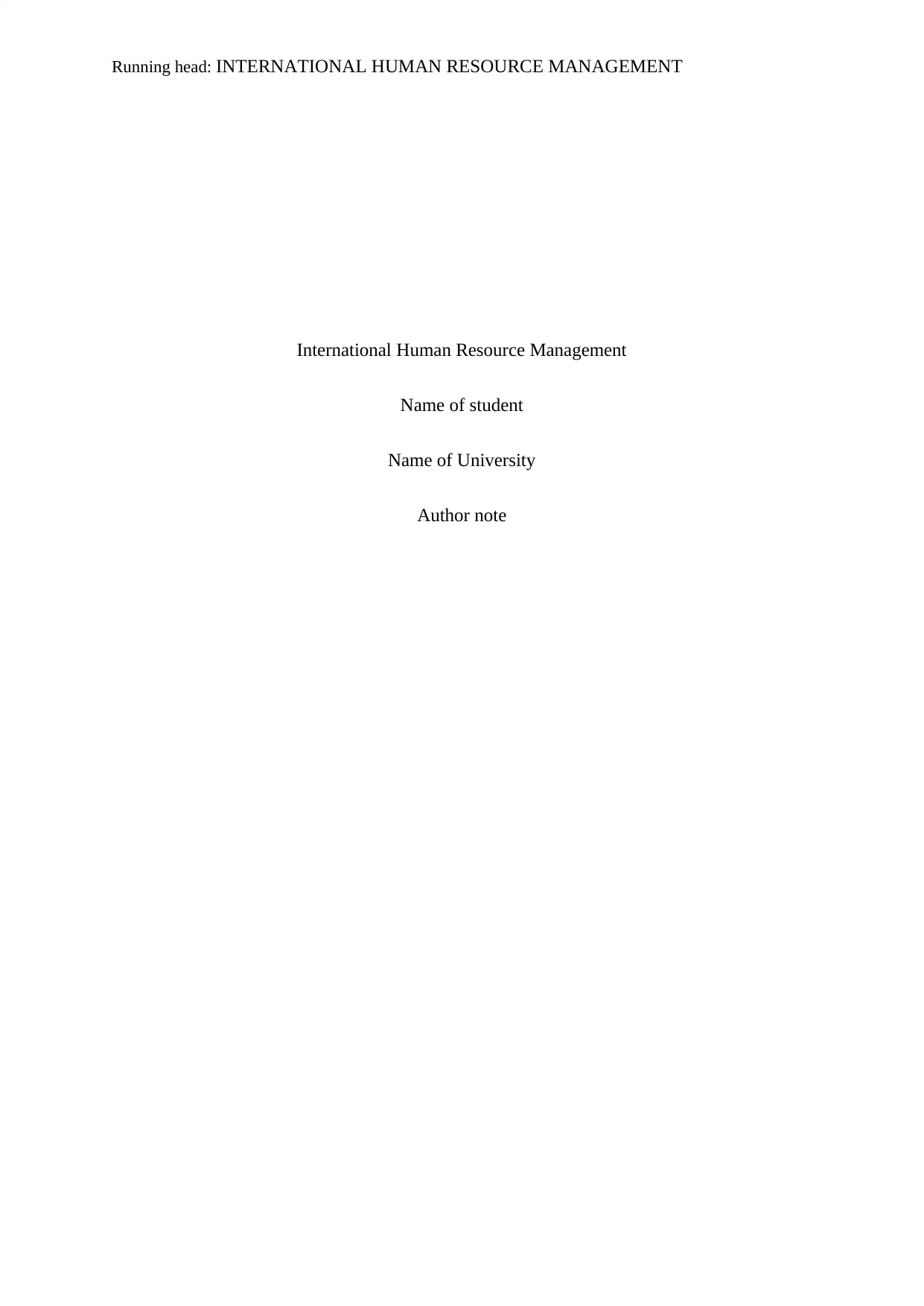
Running head: INTERNATIONAL HUMAN RESOURCE MANAGEMENT
International Human Resource Management
Name of student
Name of University
Author note
International Human Resource Management
Name of student
Name of University
Author note
Secure Best Marks with AI Grader
Need help grading? Try our AI Grader for instant feedback on your assignments.
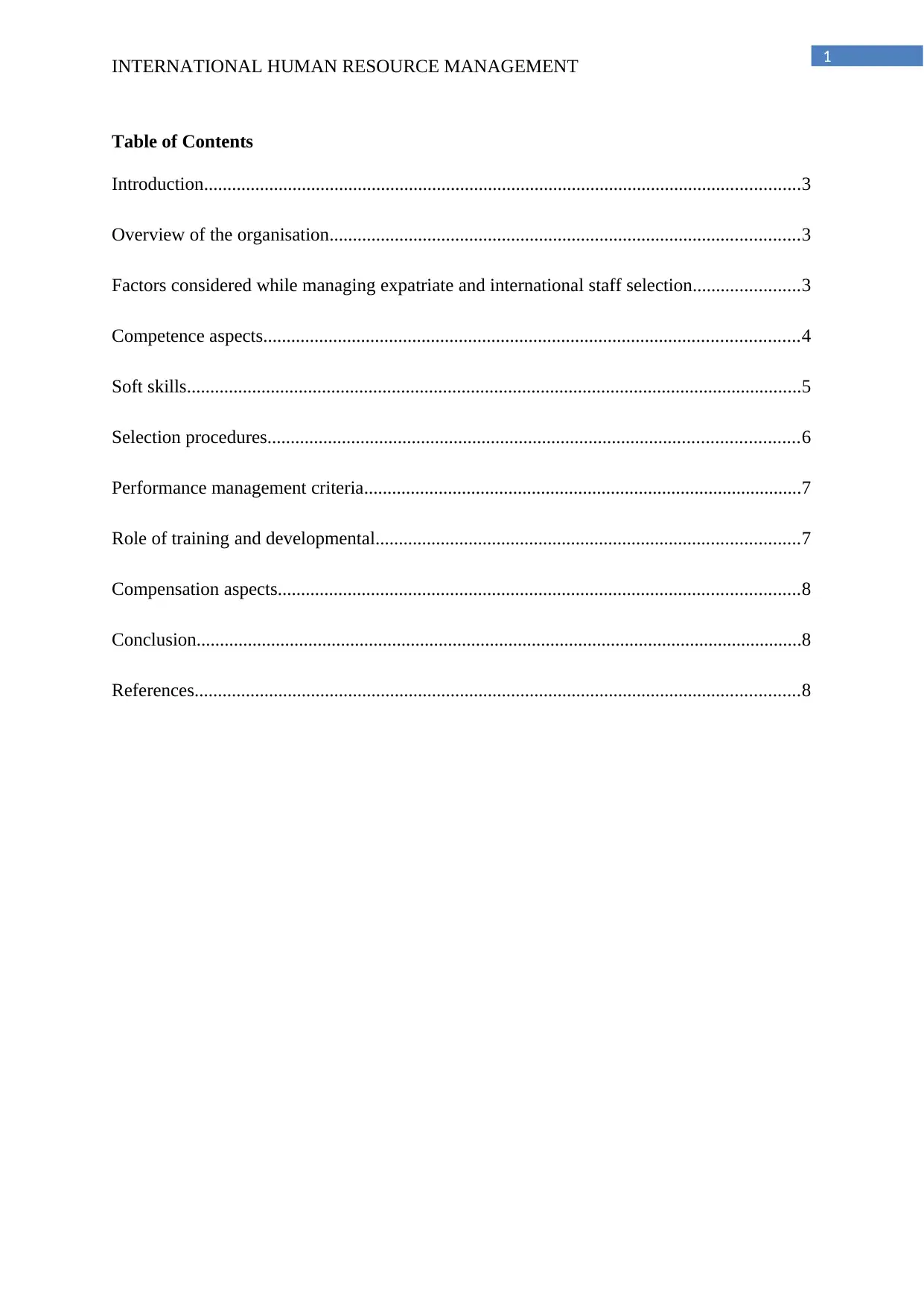
1
INTERNATIONAL HUMAN RESOURCE MANAGEMENT
Table of Contents
Introduction................................................................................................................................3
Overview of the organisation.....................................................................................................3
Factors considered while managing expatriate and international staff selection.......................3
Competence aspects...................................................................................................................4
Soft skills....................................................................................................................................5
Selection procedures..................................................................................................................6
Performance management criteria..............................................................................................7
Role of training and developmental...........................................................................................7
Compensation aspects................................................................................................................8
Conclusion..................................................................................................................................8
References..................................................................................................................................8
INTERNATIONAL HUMAN RESOURCE MANAGEMENT
Table of Contents
Introduction................................................................................................................................3
Overview of the organisation.....................................................................................................3
Factors considered while managing expatriate and international staff selection.......................3
Competence aspects...................................................................................................................4
Soft skills....................................................................................................................................5
Selection procedures..................................................................................................................6
Performance management criteria..............................................................................................7
Role of training and developmental...........................................................................................7
Compensation aspects................................................................................................................8
Conclusion..................................................................................................................................8
References..................................................................................................................................8
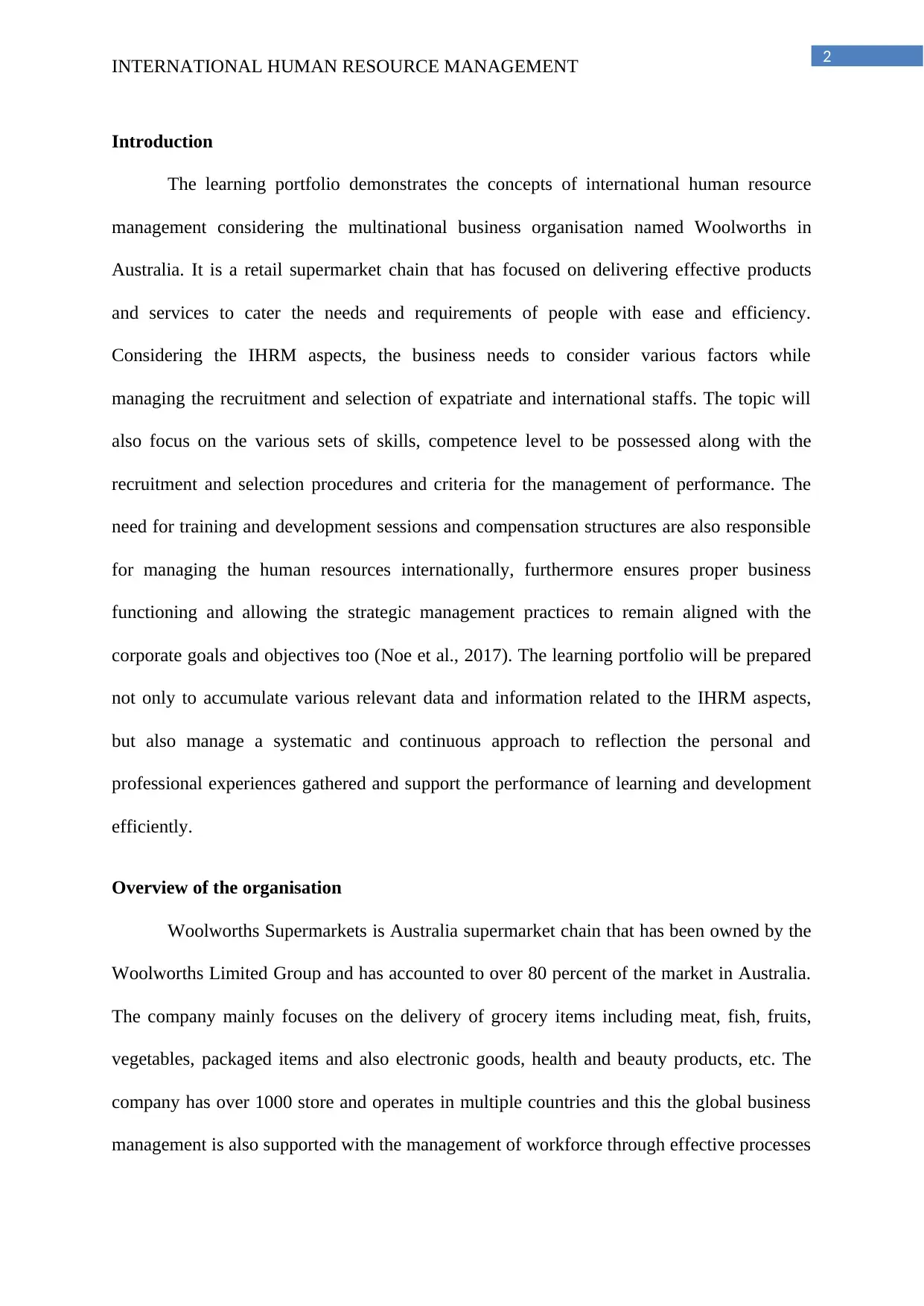
2
INTERNATIONAL HUMAN RESOURCE MANAGEMENT
Introduction
The learning portfolio demonstrates the concepts of international human resource
management considering the multinational business organisation named Woolworths in
Australia. It is a retail supermarket chain that has focused on delivering effective products
and services to cater the needs and requirements of people with ease and efficiency.
Considering the IHRM aspects, the business needs to consider various factors while
managing the recruitment and selection of expatriate and international staffs. The topic will
also focus on the various sets of skills, competence level to be possessed along with the
recruitment and selection procedures and criteria for the management of performance. The
need for training and development sessions and compensation structures are also responsible
for managing the human resources internationally, furthermore ensures proper business
functioning and allowing the strategic management practices to remain aligned with the
corporate goals and objectives too (Noe et al., 2017). The learning portfolio will be prepared
not only to accumulate various relevant data and information related to the IHRM aspects,
but also manage a systematic and continuous approach to reflection the personal and
professional experiences gathered and support the performance of learning and development
efficiently.
Overview of the organisation
Woolworths Supermarkets is Australia supermarket chain that has been owned by the
Woolworths Limited Group and has accounted to over 80 percent of the market in Australia.
The company mainly focuses on the delivery of grocery items including meat, fish, fruits,
vegetables, packaged items and also electronic goods, health and beauty products, etc. The
company has over 1000 store and operates in multiple countries and this the global business
management is also supported with the management of workforce through effective processes
INTERNATIONAL HUMAN RESOURCE MANAGEMENT
Introduction
The learning portfolio demonstrates the concepts of international human resource
management considering the multinational business organisation named Woolworths in
Australia. It is a retail supermarket chain that has focused on delivering effective products
and services to cater the needs and requirements of people with ease and efficiency.
Considering the IHRM aspects, the business needs to consider various factors while
managing the recruitment and selection of expatriate and international staffs. The topic will
also focus on the various sets of skills, competence level to be possessed along with the
recruitment and selection procedures and criteria for the management of performance. The
need for training and development sessions and compensation structures are also responsible
for managing the human resources internationally, furthermore ensures proper business
functioning and allowing the strategic management practices to remain aligned with the
corporate goals and objectives too (Noe et al., 2017). The learning portfolio will be prepared
not only to accumulate various relevant data and information related to the IHRM aspects,
but also manage a systematic and continuous approach to reflection the personal and
professional experiences gathered and support the performance of learning and development
efficiently.
Overview of the organisation
Woolworths Supermarkets is Australia supermarket chain that has been owned by the
Woolworths Limited Group and has accounted to over 80 percent of the market in Australia.
The company mainly focuses on the delivery of grocery items including meat, fish, fruits,
vegetables, packaged items and also electronic goods, health and beauty products, etc. The
company has over 1000 store and operates in multiple countries and this the global business
management is also supported with the management of workforce through effective processes
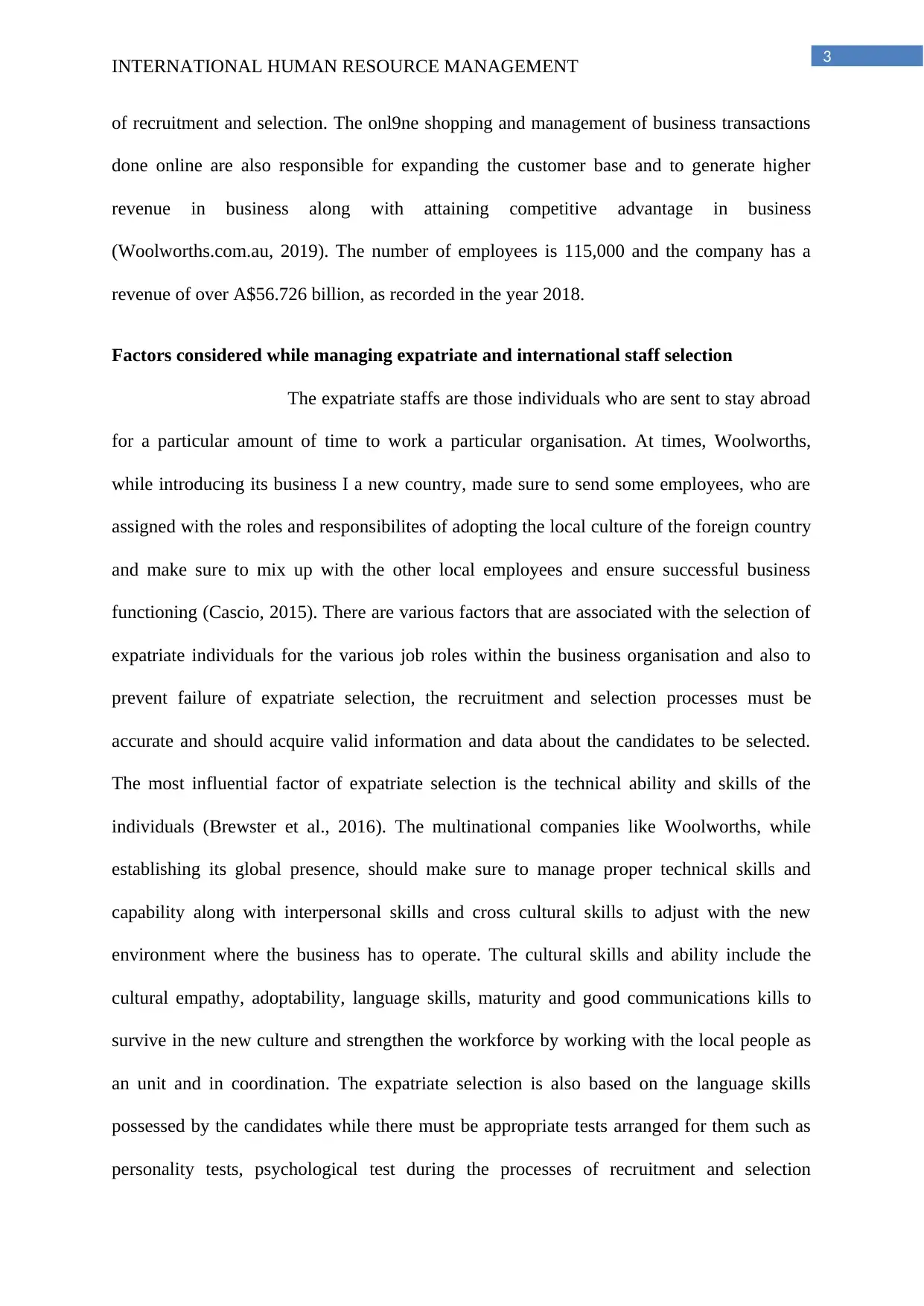
3
INTERNATIONAL HUMAN RESOURCE MANAGEMENT
of recruitment and selection. The onl9ne shopping and management of business transactions
done online are also responsible for expanding the customer base and to generate higher
revenue in business along with attaining competitive advantage in business
(Woolworths.com.au, 2019). The number of employees is 115,000 and the company has a
revenue of over A$56.726 billion, as recorded in the year 2018.
Factors considered while managing expatriate and international staff selection
The expatriate staffs are those individuals who are sent to stay abroad
for a particular amount of time to work a particular organisation. At times, Woolworths,
while introducing its business I a new country, made sure to send some employees, who are
assigned with the roles and responsibilites of adopting the local culture of the foreign country
and make sure to mix up with the other local employees and ensure successful business
functioning (Cascio, 2015). There are various factors that are associated with the selection of
expatriate individuals for the various job roles within the business organisation and also to
prevent failure of expatriate selection, the recruitment and selection processes must be
accurate and should acquire valid information and data about the candidates to be selected.
The most influential factor of expatriate selection is the technical ability and skills of the
individuals (Brewster et al., 2016). The multinational companies like Woolworths, while
establishing its global presence, should make sure to manage proper technical skills and
capability along with interpersonal skills and cross cultural skills to adjust with the new
environment where the business has to operate. The cultural skills and ability include the
cultural empathy, adoptability, language skills, maturity and good communications kills to
survive in the new culture and strengthen the workforce by working with the local people as
an unit and in coordination. The expatriate selection is also based on the language skills
possessed by the candidates while there must be appropriate tests arranged for them such as
personality tests, psychological test during the processes of recruitment and selection
INTERNATIONAL HUMAN RESOURCE MANAGEMENT
of recruitment and selection. The onl9ne shopping and management of business transactions
done online are also responsible for expanding the customer base and to generate higher
revenue in business along with attaining competitive advantage in business
(Woolworths.com.au, 2019). The number of employees is 115,000 and the company has a
revenue of over A$56.726 billion, as recorded in the year 2018.
Factors considered while managing expatriate and international staff selection
The expatriate staffs are those individuals who are sent to stay abroad
for a particular amount of time to work a particular organisation. At times, Woolworths,
while introducing its business I a new country, made sure to send some employees, who are
assigned with the roles and responsibilites of adopting the local culture of the foreign country
and make sure to mix up with the other local employees and ensure successful business
functioning (Cascio, 2015). There are various factors that are associated with the selection of
expatriate individuals for the various job roles within the business organisation and also to
prevent failure of expatriate selection, the recruitment and selection processes must be
accurate and should acquire valid information and data about the candidates to be selected.
The most influential factor of expatriate selection is the technical ability and skills of the
individuals (Brewster et al., 2016). The multinational companies like Woolworths, while
establishing its global presence, should make sure to manage proper technical skills and
capability along with interpersonal skills and cross cultural skills to adjust with the new
environment where the business has to operate. The cultural skills and ability include the
cultural empathy, adoptability, language skills, maturity and good communications kills to
survive in the new culture and strengthen the workforce by working with the local people as
an unit and in coordination. The expatriate selection is also based on the language skills
possessed by the candidates while there must be appropriate tests arranged for them such as
personality tests, psychological test during the processes of recruitment and selection
Secure Best Marks with AI Grader
Need help grading? Try our AI Grader for instant feedback on your assignments.
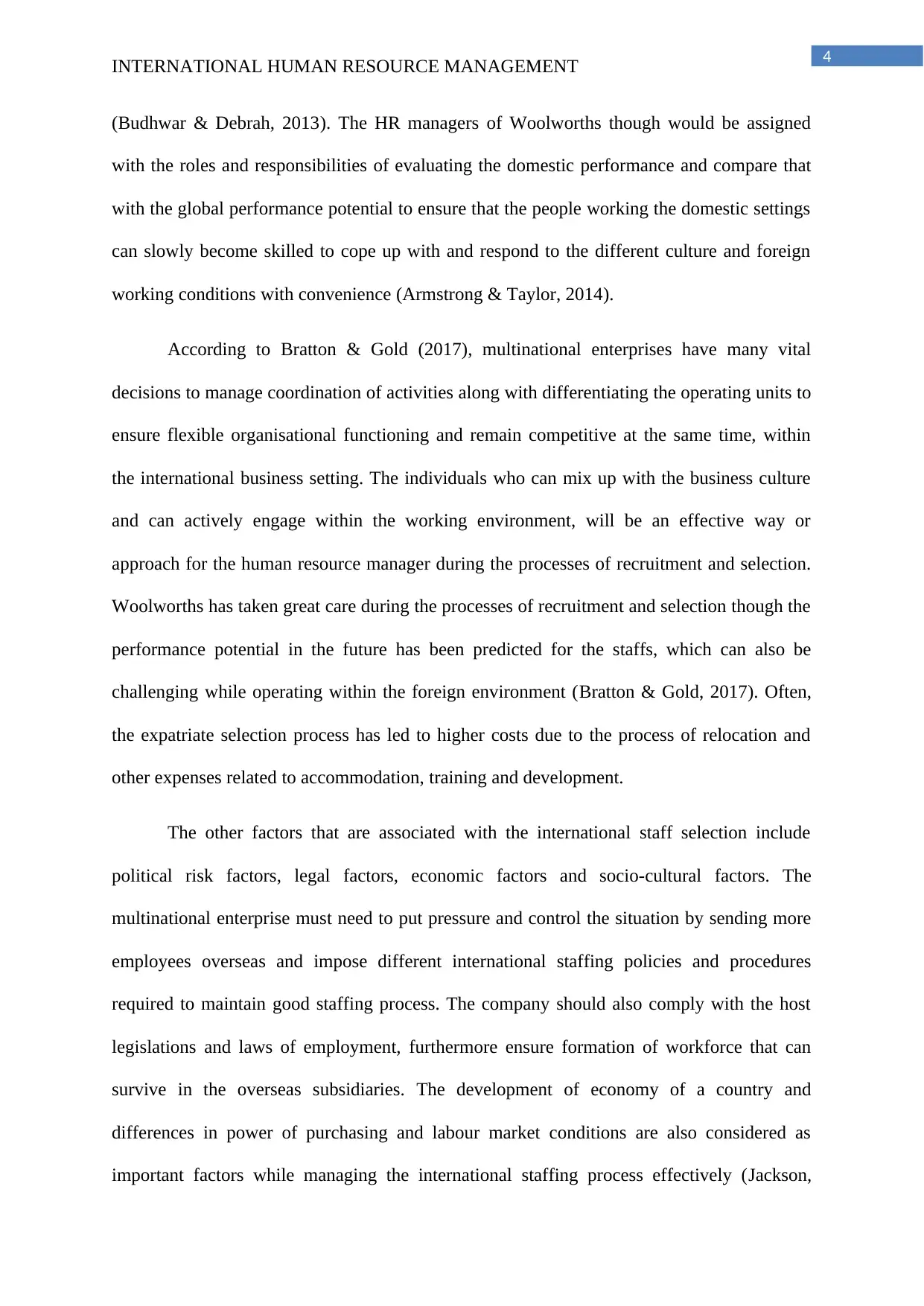
4
INTERNATIONAL HUMAN RESOURCE MANAGEMENT
(Budhwar & Debrah, 2013). The HR managers of Woolworths though would be assigned
with the roles and responsibilities of evaluating the domestic performance and compare that
with the global performance potential to ensure that the people working the domestic settings
can slowly become skilled to cope up with and respond to the different culture and foreign
working conditions with convenience (Armstrong & Taylor, 2014).
According to Bratton & Gold (2017), multinational enterprises have many vital
decisions to manage coordination of activities along with differentiating the operating units to
ensure flexible organisational functioning and remain competitive at the same time, within
the international business setting. The individuals who can mix up with the business culture
and can actively engage within the working environment, will be an effective way or
approach for the human resource manager during the processes of recruitment and selection.
Woolworths has taken great care during the processes of recruitment and selection though the
performance potential in the future has been predicted for the staffs, which can also be
challenging while operating within the foreign environment (Bratton & Gold, 2017). Often,
the expatriate selection process has led to higher costs due to the process of relocation and
other expenses related to accommodation, training and development.
The other factors that are associated with the international staff selection include
political risk factors, legal factors, economic factors and socio-cultural factors. The
multinational enterprise must need to put pressure and control the situation by sending more
employees overseas and impose different international staffing policies and procedures
required to maintain good staffing process. The company should also comply with the host
legislations and laws of employment, furthermore ensure formation of workforce that can
survive in the overseas subsidiaries. The development of economy of a country and
differences in power of purchasing and labour market conditions are also considered as
important factors while managing the international staffing process effectively (Jackson,
INTERNATIONAL HUMAN RESOURCE MANAGEMENT
(Budhwar & Debrah, 2013). The HR managers of Woolworths though would be assigned
with the roles and responsibilities of evaluating the domestic performance and compare that
with the global performance potential to ensure that the people working the domestic settings
can slowly become skilled to cope up with and respond to the different culture and foreign
working conditions with convenience (Armstrong & Taylor, 2014).
According to Bratton & Gold (2017), multinational enterprises have many vital
decisions to manage coordination of activities along with differentiating the operating units to
ensure flexible organisational functioning and remain competitive at the same time, within
the international business setting. The individuals who can mix up with the business culture
and can actively engage within the working environment, will be an effective way or
approach for the human resource manager during the processes of recruitment and selection.
Woolworths has taken great care during the processes of recruitment and selection though the
performance potential in the future has been predicted for the staffs, which can also be
challenging while operating within the foreign environment (Bratton & Gold, 2017). Often,
the expatriate selection process has led to higher costs due to the process of relocation and
other expenses related to accommodation, training and development.
The other factors that are associated with the international staff selection include
political risk factors, legal factors, economic factors and socio-cultural factors. The
multinational enterprise must need to put pressure and control the situation by sending more
employees overseas and impose different international staffing policies and procedures
required to maintain good staffing process. The company should also comply with the host
legislations and laws of employment, furthermore ensure formation of workforce that can
survive in the overseas subsidiaries. The development of economy of a country and
differences in power of purchasing and labour market conditions are also considered as
important factors while managing the international staffing process effectively (Jackson,
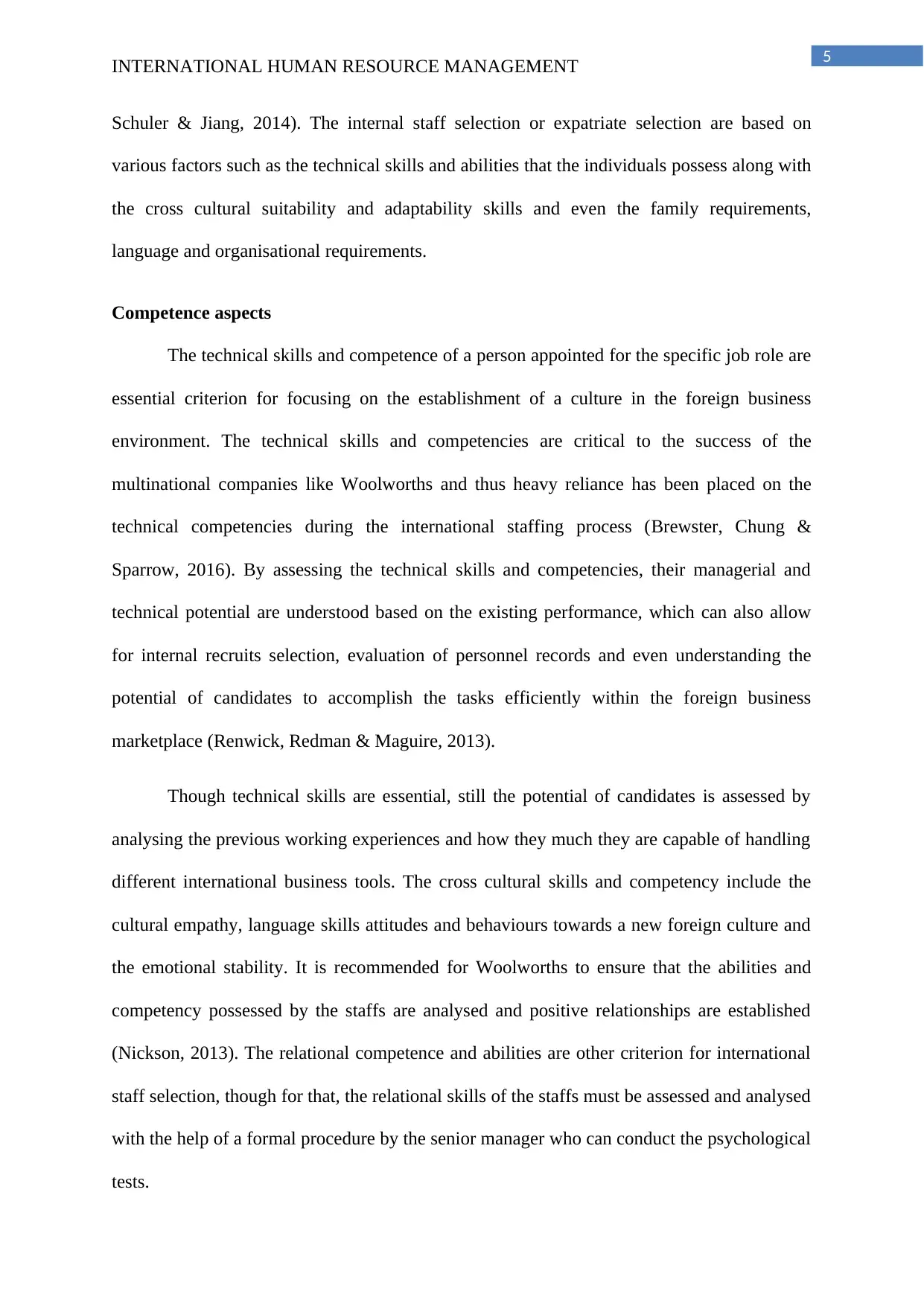
5
INTERNATIONAL HUMAN RESOURCE MANAGEMENT
Schuler & Jiang, 2014). The internal staff selection or expatriate selection are based on
various factors such as the technical skills and abilities that the individuals possess along with
the cross cultural suitability and adaptability skills and even the family requirements,
language and organisational requirements.
Competence aspects
The technical skills and competence of a person appointed for the specific job role are
essential criterion for focusing on the establishment of a culture in the foreign business
environment. The technical skills and competencies are critical to the success of the
multinational companies like Woolworths and thus heavy reliance has been placed on the
technical competencies during the international staffing process (Brewster, Chung &
Sparrow, 2016). By assessing the technical skills and competencies, their managerial and
technical potential are understood based on the existing performance, which can also allow
for internal recruits selection, evaluation of personnel records and even understanding the
potential of candidates to accomplish the tasks efficiently within the foreign business
marketplace (Renwick, Redman & Maguire, 2013).
Though technical skills are essential, still the potential of candidates is assessed by
analysing the previous working experiences and how they much they are capable of handling
different international business tools. The cross cultural skills and competency include the
cultural empathy, language skills attitudes and behaviours towards a new foreign culture and
the emotional stability. It is recommended for Woolworths to ensure that the abilities and
competency possessed by the staffs are analysed and positive relationships are established
(Nickson, 2013). The relational competence and abilities are other criterion for international
staff selection, though for that, the relational skills of the staffs must be assessed and analysed
with the help of a formal procedure by the senior manager who can conduct the psychological
tests.
INTERNATIONAL HUMAN RESOURCE MANAGEMENT
Schuler & Jiang, 2014). The internal staff selection or expatriate selection are based on
various factors such as the technical skills and abilities that the individuals possess along with
the cross cultural suitability and adaptability skills and even the family requirements,
language and organisational requirements.
Competence aspects
The technical skills and competence of a person appointed for the specific job role are
essential criterion for focusing on the establishment of a culture in the foreign business
environment. The technical skills and competencies are critical to the success of the
multinational companies like Woolworths and thus heavy reliance has been placed on the
technical competencies during the international staffing process (Brewster, Chung &
Sparrow, 2016). By assessing the technical skills and competencies, their managerial and
technical potential are understood based on the existing performance, which can also allow
for internal recruits selection, evaluation of personnel records and even understanding the
potential of candidates to accomplish the tasks efficiently within the foreign business
marketplace (Renwick, Redman & Maguire, 2013).
Though technical skills are essential, still the potential of candidates is assessed by
analysing the previous working experiences and how they much they are capable of handling
different international business tools. The cross cultural skills and competency include the
cultural empathy, language skills attitudes and behaviours towards a new foreign culture and
the emotional stability. It is recommended for Woolworths to ensure that the abilities and
competency possessed by the staffs are analysed and positive relationships are established
(Nickson, 2013). The relational competence and abilities are other criterion for international
staff selection, though for that, the relational skills of the staffs must be assessed and analysed
with the help of a formal procedure by the senior manager who can conduct the psychological
tests.
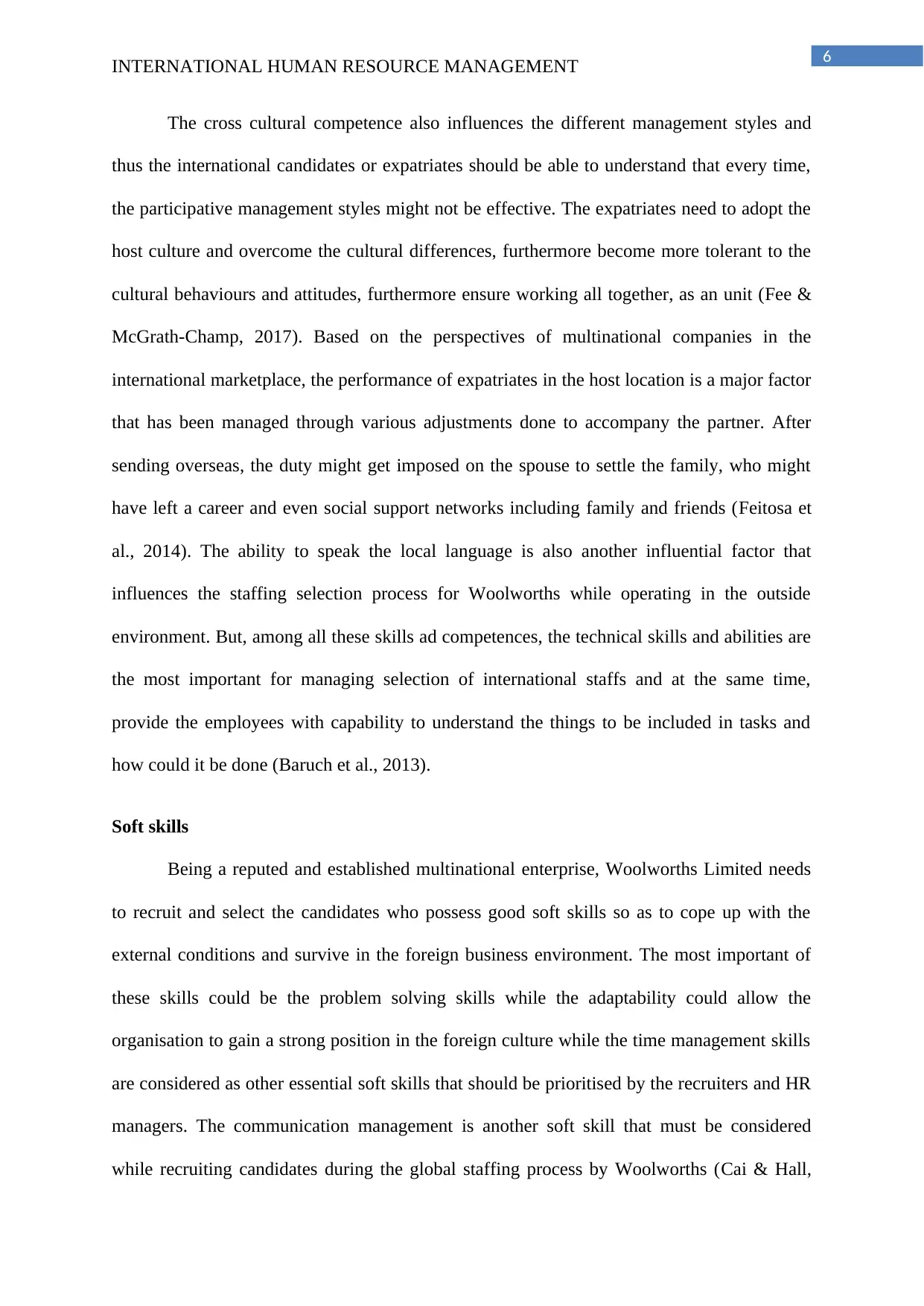
6
INTERNATIONAL HUMAN RESOURCE MANAGEMENT
The cross cultural competence also influences the different management styles and
thus the international candidates or expatriates should be able to understand that every time,
the participative management styles might not be effective. The expatriates need to adopt the
host culture and overcome the cultural differences, furthermore become more tolerant to the
cultural behaviours and attitudes, furthermore ensure working all together, as an unit (Fee &
McGrath-Champ, 2017). Based on the perspectives of multinational companies in the
international marketplace, the performance of expatriates in the host location is a major factor
that has been managed through various adjustments done to accompany the partner. After
sending overseas, the duty might get imposed on the spouse to settle the family, who might
have left a career and even social support networks including family and friends (Feitosa et
al., 2014). The ability to speak the local language is also another influential factor that
influences the staffing selection process for Woolworths while operating in the outside
environment. But, among all these skills ad competences, the technical skills and abilities are
the most important for managing selection of international staffs and at the same time,
provide the employees with capability to understand the things to be included in tasks and
how could it be done (Baruch et al., 2013).
Soft skills
Being a reputed and established multinational enterprise, Woolworths Limited needs
to recruit and select the candidates who possess good soft skills so as to cope up with the
external conditions and survive in the foreign business environment. The most important of
these skills could be the problem solving skills while the adaptability could allow the
organisation to gain a strong position in the foreign culture while the time management skills
are considered as other essential soft skills that should be prioritised by the recruiters and HR
managers. The communication management is another soft skill that must be considered
while recruiting candidates during the global staffing process by Woolworths (Cai & Hall,
INTERNATIONAL HUMAN RESOURCE MANAGEMENT
The cross cultural competence also influences the different management styles and
thus the international candidates or expatriates should be able to understand that every time,
the participative management styles might not be effective. The expatriates need to adopt the
host culture and overcome the cultural differences, furthermore become more tolerant to the
cultural behaviours and attitudes, furthermore ensure working all together, as an unit (Fee &
McGrath-Champ, 2017). Based on the perspectives of multinational companies in the
international marketplace, the performance of expatriates in the host location is a major factor
that has been managed through various adjustments done to accompany the partner. After
sending overseas, the duty might get imposed on the spouse to settle the family, who might
have left a career and even social support networks including family and friends (Feitosa et
al., 2014). The ability to speak the local language is also another influential factor that
influences the staffing selection process for Woolworths while operating in the outside
environment. But, among all these skills ad competences, the technical skills and abilities are
the most important for managing selection of international staffs and at the same time,
provide the employees with capability to understand the things to be included in tasks and
how could it be done (Baruch et al., 2013).
Soft skills
Being a reputed and established multinational enterprise, Woolworths Limited needs
to recruit and select the candidates who possess good soft skills so as to cope up with the
external conditions and survive in the foreign business environment. The most important of
these skills could be the problem solving skills while the adaptability could allow the
organisation to gain a strong position in the foreign culture while the time management skills
are considered as other essential soft skills that should be prioritised by the recruiters and HR
managers. The communication management is another soft skill that must be considered
while recruiting candidates during the global staffing process by Woolworths (Cai & Hall,
Paraphrase This Document
Need a fresh take? Get an instant paraphrase of this document with our AI Paraphraser
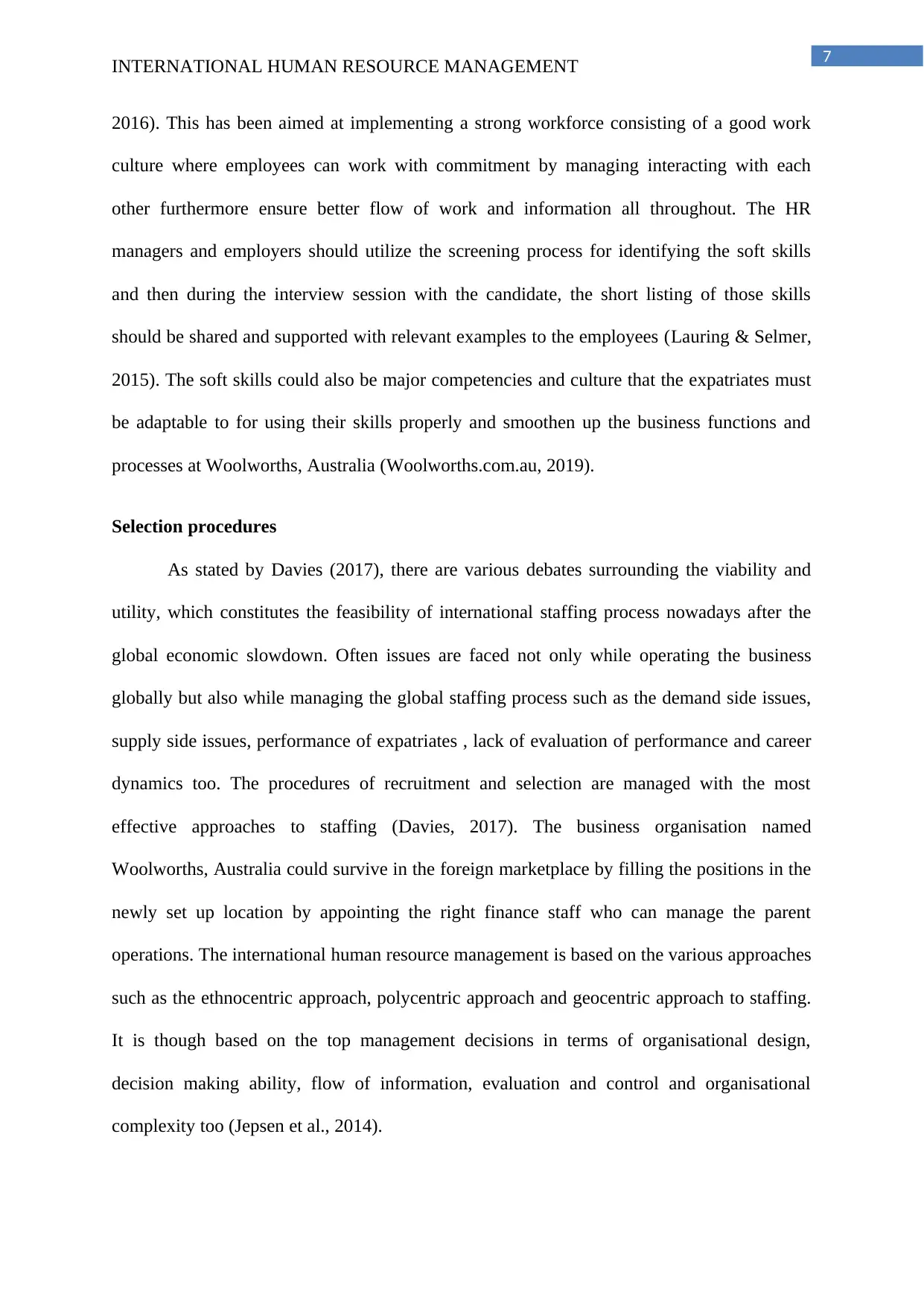
7
INTERNATIONAL HUMAN RESOURCE MANAGEMENT
2016). This has been aimed at implementing a strong workforce consisting of a good work
culture where employees can work with commitment by managing interacting with each
other furthermore ensure better flow of work and information all throughout. The HR
managers and employers should utilize the screening process for identifying the soft skills
and then during the interview session with the candidate, the short listing of those skills
should be shared and supported with relevant examples to the employees (Lauring & Selmer,
2015). The soft skills could also be major competencies and culture that the expatriates must
be adaptable to for using their skills properly and smoothen up the business functions and
processes at Woolworths, Australia (Woolworths.com.au, 2019).
Selection procedures
As stated by Davies (2017), there are various debates surrounding the viability and
utility, which constitutes the feasibility of international staffing process nowadays after the
global economic slowdown. Often issues are faced not only while operating the business
globally but also while managing the global staffing process such as the demand side issues,
supply side issues, performance of expatriates , lack of evaluation of performance and career
dynamics too. The procedures of recruitment and selection are managed with the most
effective approaches to staffing (Davies, 2017). The business organisation named
Woolworths, Australia could survive in the foreign marketplace by filling the positions in the
newly set up location by appointing the right finance staff who can manage the parent
operations. The international human resource management is based on the various approaches
such as the ethnocentric approach, polycentric approach and geocentric approach to staffing.
It is though based on the top management decisions in terms of organisational design,
decision making ability, flow of information, evaluation and control and organisational
complexity too (Jepsen et al., 2014).
INTERNATIONAL HUMAN RESOURCE MANAGEMENT
2016). This has been aimed at implementing a strong workforce consisting of a good work
culture where employees can work with commitment by managing interacting with each
other furthermore ensure better flow of work and information all throughout. The HR
managers and employers should utilize the screening process for identifying the soft skills
and then during the interview session with the candidate, the short listing of those skills
should be shared and supported with relevant examples to the employees (Lauring & Selmer,
2015). The soft skills could also be major competencies and culture that the expatriates must
be adaptable to for using their skills properly and smoothen up the business functions and
processes at Woolworths, Australia (Woolworths.com.au, 2019).
Selection procedures
As stated by Davies (2017), there are various debates surrounding the viability and
utility, which constitutes the feasibility of international staffing process nowadays after the
global economic slowdown. Often issues are faced not only while operating the business
globally but also while managing the global staffing process such as the demand side issues,
supply side issues, performance of expatriates , lack of evaluation of performance and career
dynamics too. The procedures of recruitment and selection are managed with the most
effective approaches to staffing (Davies, 2017). The business organisation named
Woolworths, Australia could survive in the foreign marketplace by filling the positions in the
newly set up location by appointing the right finance staff who can manage the parent
operations. The international human resource management is based on the various approaches
such as the ethnocentric approach, polycentric approach and geocentric approach to staffing.
It is though based on the top management decisions in terms of organisational design,
decision making ability, flow of information, evaluation and control and organisational
complexity too (Jepsen et al., 2014).
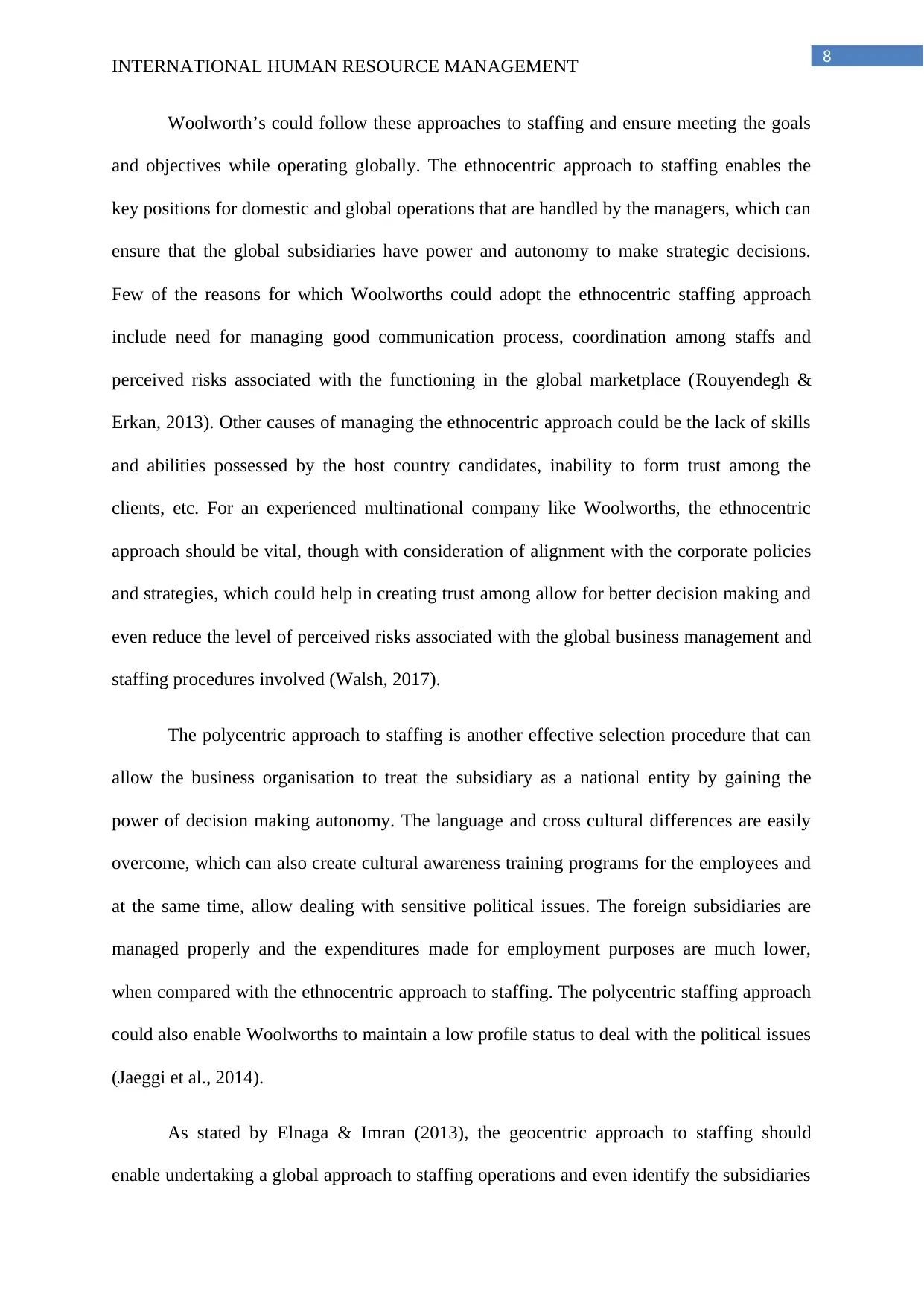
8
INTERNATIONAL HUMAN RESOURCE MANAGEMENT
Woolworth’s could follow these approaches to staffing and ensure meeting the goals
and objectives while operating globally. The ethnocentric approach to staffing enables the
key positions for domestic and global operations that are handled by the managers, which can
ensure that the global subsidiaries have power and autonomy to make strategic decisions.
Few of the reasons for which Woolworths could adopt the ethnocentric staffing approach
include need for managing good communication process, coordination among staffs and
perceived risks associated with the functioning in the global marketplace (Rouyendegh &
Erkan, 2013). Other causes of managing the ethnocentric approach could be the lack of skills
and abilities possessed by the host country candidates, inability to form trust among the
clients, etc. For an experienced multinational company like Woolworths, the ethnocentric
approach should be vital, though with consideration of alignment with the corporate policies
and strategies, which could help in creating trust among allow for better decision making and
even reduce the level of perceived risks associated with the global business management and
staffing procedures involved (Walsh, 2017).
The polycentric approach to staffing is another effective selection procedure that can
allow the business organisation to treat the subsidiary as a national entity by gaining the
power of decision making autonomy. The language and cross cultural differences are easily
overcome, which can also create cultural awareness training programs for the employees and
at the same time, allow dealing with sensitive political issues. The foreign subsidiaries are
managed properly and the expenditures made for employment purposes are much lower,
when compared with the ethnocentric approach to staffing. The polycentric staffing approach
could also enable Woolworths to maintain a low profile status to deal with the political issues
(Jaeggi et al., 2014).
As stated by Elnaga & Imran (2013), the geocentric approach to staffing should
enable undertaking a global approach to staffing operations and even identify the subsidiaries
INTERNATIONAL HUMAN RESOURCE MANAGEMENT
Woolworth’s could follow these approaches to staffing and ensure meeting the goals
and objectives while operating globally. The ethnocentric approach to staffing enables the
key positions for domestic and global operations that are handled by the managers, which can
ensure that the global subsidiaries have power and autonomy to make strategic decisions.
Few of the reasons for which Woolworths could adopt the ethnocentric staffing approach
include need for managing good communication process, coordination among staffs and
perceived risks associated with the functioning in the global marketplace (Rouyendegh &
Erkan, 2013). Other causes of managing the ethnocentric approach could be the lack of skills
and abilities possessed by the host country candidates, inability to form trust among the
clients, etc. For an experienced multinational company like Woolworths, the ethnocentric
approach should be vital, though with consideration of alignment with the corporate policies
and strategies, which could help in creating trust among allow for better decision making and
even reduce the level of perceived risks associated with the global business management and
staffing procedures involved (Walsh, 2017).
The polycentric approach to staffing is another effective selection procedure that can
allow the business organisation to treat the subsidiary as a national entity by gaining the
power of decision making autonomy. The language and cross cultural differences are easily
overcome, which can also create cultural awareness training programs for the employees and
at the same time, allow dealing with sensitive political issues. The foreign subsidiaries are
managed properly and the expenditures made for employment purposes are much lower,
when compared with the ethnocentric approach to staffing. The polycentric staffing approach
could also enable Woolworths to maintain a low profile status to deal with the political issues
(Jaeggi et al., 2014).
As stated by Elnaga & Imran (2013), the geocentric approach to staffing should
enable undertaking a global approach to staffing operations and even identify the subsidiaries
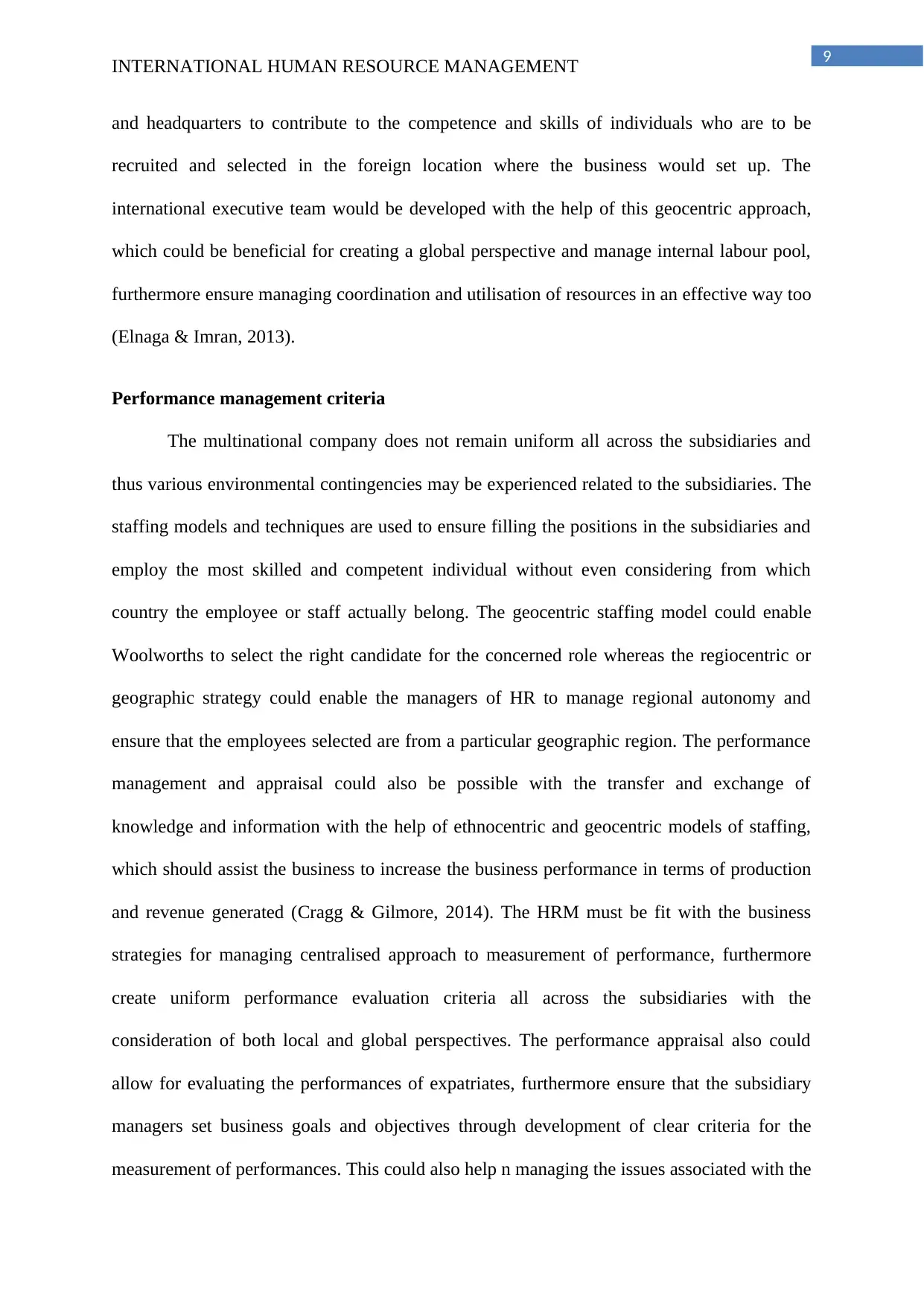
9
INTERNATIONAL HUMAN RESOURCE MANAGEMENT
and headquarters to contribute to the competence and skills of individuals who are to be
recruited and selected in the foreign location where the business would set up. The
international executive team would be developed with the help of this geocentric approach,
which could be beneficial for creating a global perspective and manage internal labour pool,
furthermore ensure managing coordination and utilisation of resources in an effective way too
(Elnaga & Imran, 2013).
Performance management criteria
The multinational company does not remain uniform all across the subsidiaries and
thus various environmental contingencies may be experienced related to the subsidiaries. The
staffing models and techniques are used to ensure filling the positions in the subsidiaries and
employ the most skilled and competent individual without even considering from which
country the employee or staff actually belong. The geocentric staffing model could enable
Woolworths to select the right candidate for the concerned role whereas the regiocentric or
geographic strategy could enable the managers of HR to manage regional autonomy and
ensure that the employees selected are from a particular geographic region. The performance
management and appraisal could also be possible with the transfer and exchange of
knowledge and information with the help of ethnocentric and geocentric models of staffing,
which should assist the business to increase the business performance in terms of production
and revenue generated (Cragg & Gilmore, 2014). The HRM must be fit with the business
strategies for managing centralised approach to measurement of performance, furthermore
create uniform performance evaluation criteria all across the subsidiaries with the
consideration of both local and global perspectives. The performance appraisal also could
allow for evaluating the performances of expatriates, furthermore ensure that the subsidiary
managers set business goals and objectives through development of clear criteria for the
measurement of performances. This could also help n managing the issues associated with the
INTERNATIONAL HUMAN RESOURCE MANAGEMENT
and headquarters to contribute to the competence and skills of individuals who are to be
recruited and selected in the foreign location where the business would set up. The
international executive team would be developed with the help of this geocentric approach,
which could be beneficial for creating a global perspective and manage internal labour pool,
furthermore ensure managing coordination and utilisation of resources in an effective way too
(Elnaga & Imran, 2013).
Performance management criteria
The multinational company does not remain uniform all across the subsidiaries and
thus various environmental contingencies may be experienced related to the subsidiaries. The
staffing models and techniques are used to ensure filling the positions in the subsidiaries and
employ the most skilled and competent individual without even considering from which
country the employee or staff actually belong. The geocentric staffing model could enable
Woolworths to select the right candidate for the concerned role whereas the regiocentric or
geographic strategy could enable the managers of HR to manage regional autonomy and
ensure that the employees selected are from a particular geographic region. The performance
management and appraisal could also be possible with the transfer and exchange of
knowledge and information with the help of ethnocentric and geocentric models of staffing,
which should assist the business to increase the business performance in terms of production
and revenue generated (Cragg & Gilmore, 2014). The HRM must be fit with the business
strategies for managing centralised approach to measurement of performance, furthermore
create uniform performance evaluation criteria all across the subsidiaries with the
consideration of both local and global perspectives. The performance appraisal also could
allow for evaluating the performances of expatriates, furthermore ensure that the subsidiary
managers set business goals and objectives through development of clear criteria for the
measurement of performances. This could also help n managing the issues associated with the
Secure Best Marks with AI Grader
Need help grading? Try our AI Grader for instant feedback on your assignments.
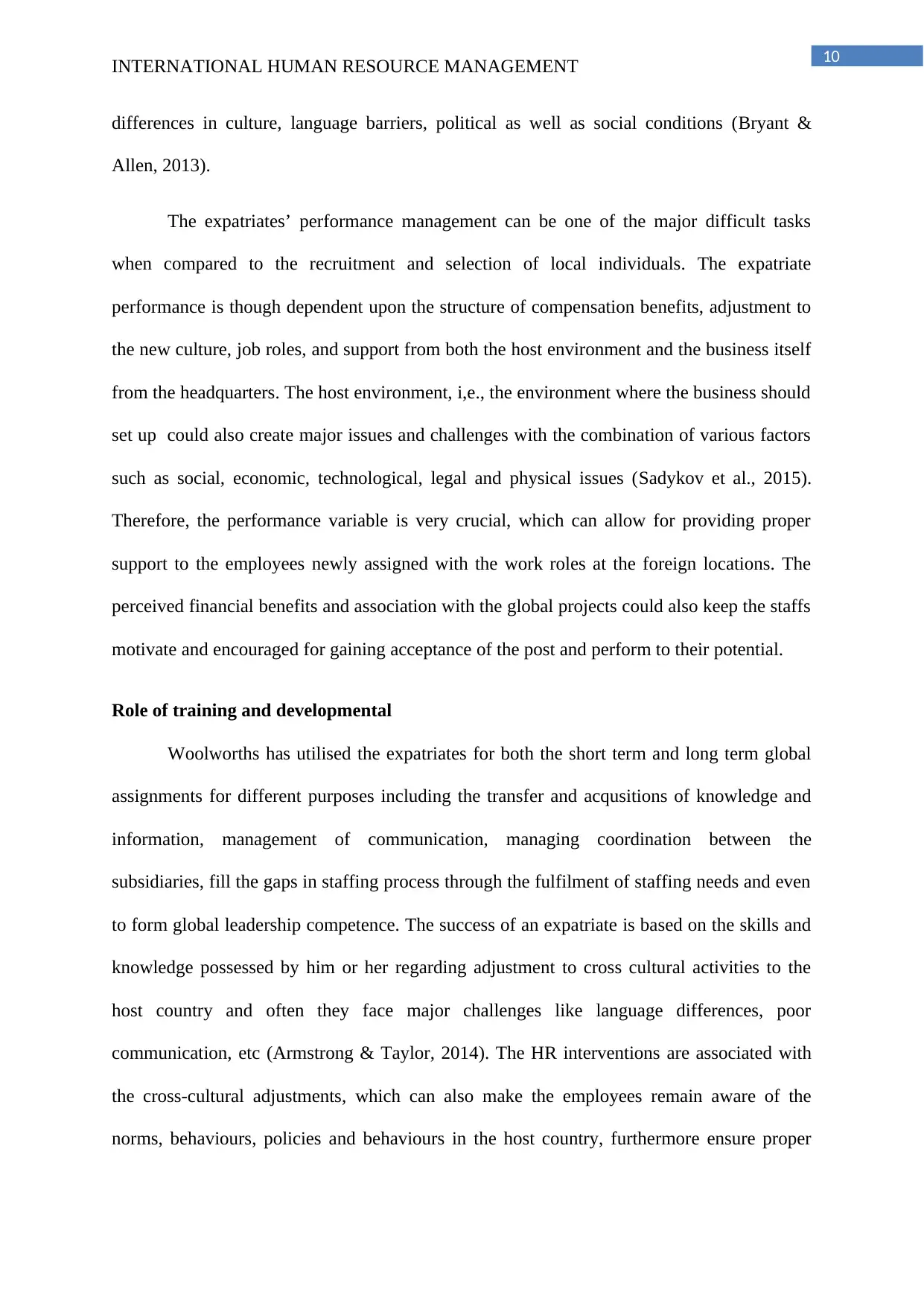
10
INTERNATIONAL HUMAN RESOURCE MANAGEMENT
differences in culture, language barriers, political as well as social conditions (Bryant &
Allen, 2013).
The expatriates’ performance management can be one of the major difficult tasks
when compared to the recruitment and selection of local individuals. The expatriate
performance is though dependent upon the structure of compensation benefits, adjustment to
the new culture, job roles, and support from both the host environment and the business itself
from the headquarters. The host environment, i,e., the environment where the business should
set up could also create major issues and challenges with the combination of various factors
such as social, economic, technological, legal and physical issues (Sadykov et al., 2015).
Therefore, the performance variable is very crucial, which can allow for providing proper
support to the employees newly assigned with the work roles at the foreign locations. The
perceived financial benefits and association with the global projects could also keep the staffs
motivate and encouraged for gaining acceptance of the post and perform to their potential.
Role of training and developmental
Woolworths has utilised the expatriates for both the short term and long term global
assignments for different purposes including the transfer and acqusitions of knowledge and
information, management of communication, managing coordination between the
subsidiaries, fill the gaps in staffing process through the fulfilment of staffing needs and even
to form global leadership competence. The success of an expatriate is based on the skills and
knowledge possessed by him or her regarding adjustment to cross cultural activities to the
host country and often they face major challenges like language differences, poor
communication, etc (Armstrong & Taylor, 2014). The HR interventions are associated with
the cross-cultural adjustments, which can also make the employees remain aware of the
norms, behaviours, policies and behaviours in the host country, furthermore ensure proper
INTERNATIONAL HUMAN RESOURCE MANAGEMENT
differences in culture, language barriers, political as well as social conditions (Bryant &
Allen, 2013).
The expatriates’ performance management can be one of the major difficult tasks
when compared to the recruitment and selection of local individuals. The expatriate
performance is though dependent upon the structure of compensation benefits, adjustment to
the new culture, job roles, and support from both the host environment and the business itself
from the headquarters. The host environment, i,e., the environment where the business should
set up could also create major issues and challenges with the combination of various factors
such as social, economic, technological, legal and physical issues (Sadykov et al., 2015).
Therefore, the performance variable is very crucial, which can allow for providing proper
support to the employees newly assigned with the work roles at the foreign locations. The
perceived financial benefits and association with the global projects could also keep the staffs
motivate and encouraged for gaining acceptance of the post and perform to their potential.
Role of training and developmental
Woolworths has utilised the expatriates for both the short term and long term global
assignments for different purposes including the transfer and acqusitions of knowledge and
information, management of communication, managing coordination between the
subsidiaries, fill the gaps in staffing process through the fulfilment of staffing needs and even
to form global leadership competence. The success of an expatriate is based on the skills and
knowledge possessed by him or her regarding adjustment to cross cultural activities to the
host country and often they face major challenges like language differences, poor
communication, etc (Armstrong & Taylor, 2014). The HR interventions are associated with
the cross-cultural adjustments, which can also make the employees remain aware of the
norms, behaviours, policies and behaviours in the host country, furthermore ensure proper
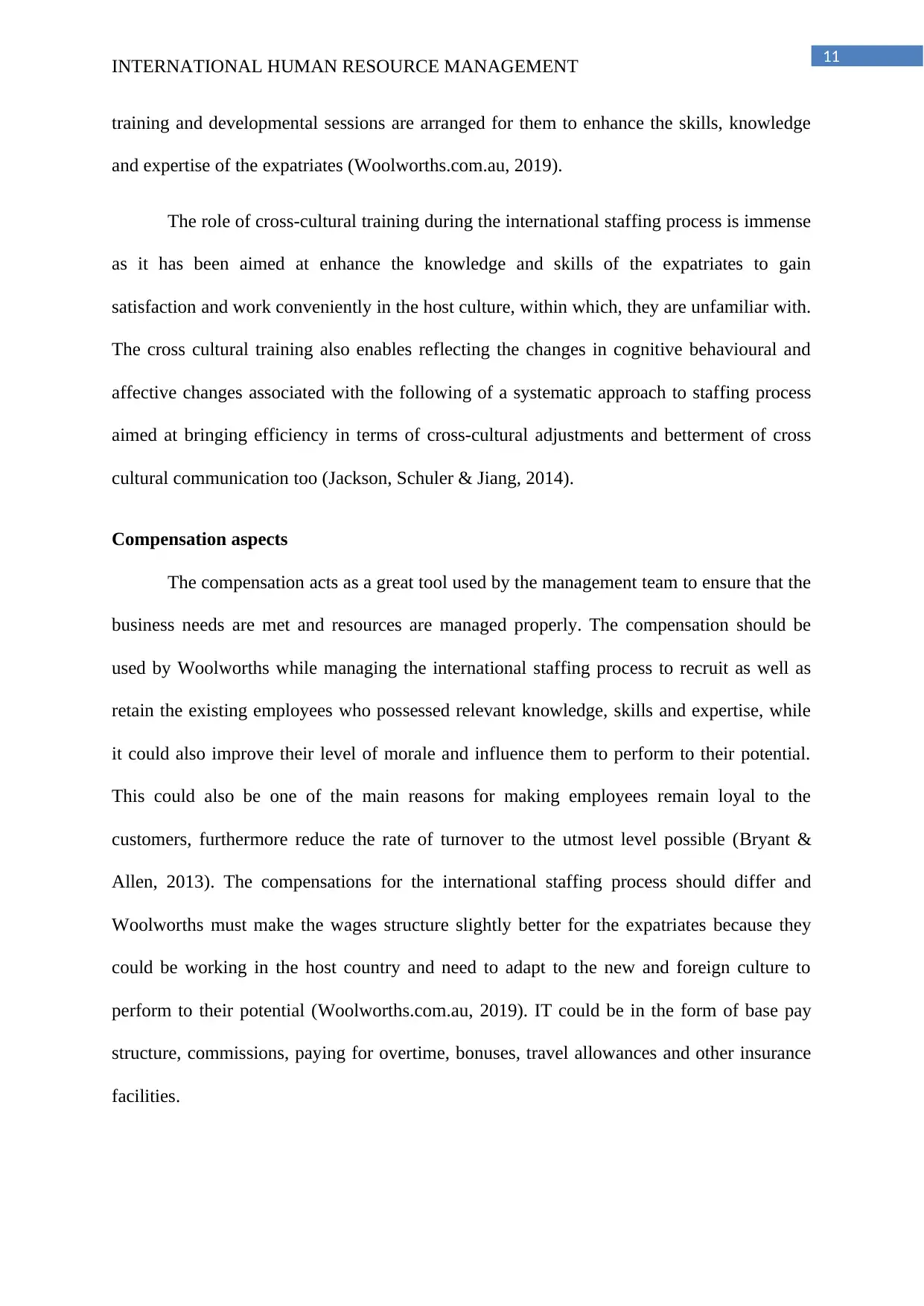
11
INTERNATIONAL HUMAN RESOURCE MANAGEMENT
training and developmental sessions are arranged for them to enhance the skills, knowledge
and expertise of the expatriates (Woolworths.com.au, 2019).
The role of cross-cultural training during the international staffing process is immense
as it has been aimed at enhance the knowledge and skills of the expatriates to gain
satisfaction and work conveniently in the host culture, within which, they are unfamiliar with.
The cross cultural training also enables reflecting the changes in cognitive behavioural and
affective changes associated with the following of a systematic approach to staffing process
aimed at bringing efficiency in terms of cross-cultural adjustments and betterment of cross
cultural communication too (Jackson, Schuler & Jiang, 2014).
Compensation aspects
The compensation acts as a great tool used by the management team to ensure that the
business needs are met and resources are managed properly. The compensation should be
used by Woolworths while managing the international staffing process to recruit as well as
retain the existing employees who possessed relevant knowledge, skills and expertise, while
it could also improve their level of morale and influence them to perform to their potential.
This could also be one of the main reasons for making employees remain loyal to the
customers, furthermore reduce the rate of turnover to the utmost level possible (Bryant &
Allen, 2013). The compensations for the international staffing process should differ and
Woolworths must make the wages structure slightly better for the expatriates because they
could be working in the host country and need to adapt to the new and foreign culture to
perform to their potential (Woolworths.com.au, 2019). IT could be in the form of base pay
structure, commissions, paying for overtime, bonuses, travel allowances and other insurance
facilities.
INTERNATIONAL HUMAN RESOURCE MANAGEMENT
training and developmental sessions are arranged for them to enhance the skills, knowledge
and expertise of the expatriates (Woolworths.com.au, 2019).
The role of cross-cultural training during the international staffing process is immense
as it has been aimed at enhance the knowledge and skills of the expatriates to gain
satisfaction and work conveniently in the host culture, within which, they are unfamiliar with.
The cross cultural training also enables reflecting the changes in cognitive behavioural and
affective changes associated with the following of a systematic approach to staffing process
aimed at bringing efficiency in terms of cross-cultural adjustments and betterment of cross
cultural communication too (Jackson, Schuler & Jiang, 2014).
Compensation aspects
The compensation acts as a great tool used by the management team to ensure that the
business needs are met and resources are managed properly. The compensation should be
used by Woolworths while managing the international staffing process to recruit as well as
retain the existing employees who possessed relevant knowledge, skills and expertise, while
it could also improve their level of morale and influence them to perform to their potential.
This could also be one of the main reasons for making employees remain loyal to the
customers, furthermore reduce the rate of turnover to the utmost level possible (Bryant &
Allen, 2013). The compensations for the international staffing process should differ and
Woolworths must make the wages structure slightly better for the expatriates because they
could be working in the host country and need to adapt to the new and foreign culture to
perform to their potential (Woolworths.com.au, 2019). IT could be in the form of base pay
structure, commissions, paying for overtime, bonuses, travel allowances and other insurance
facilities.
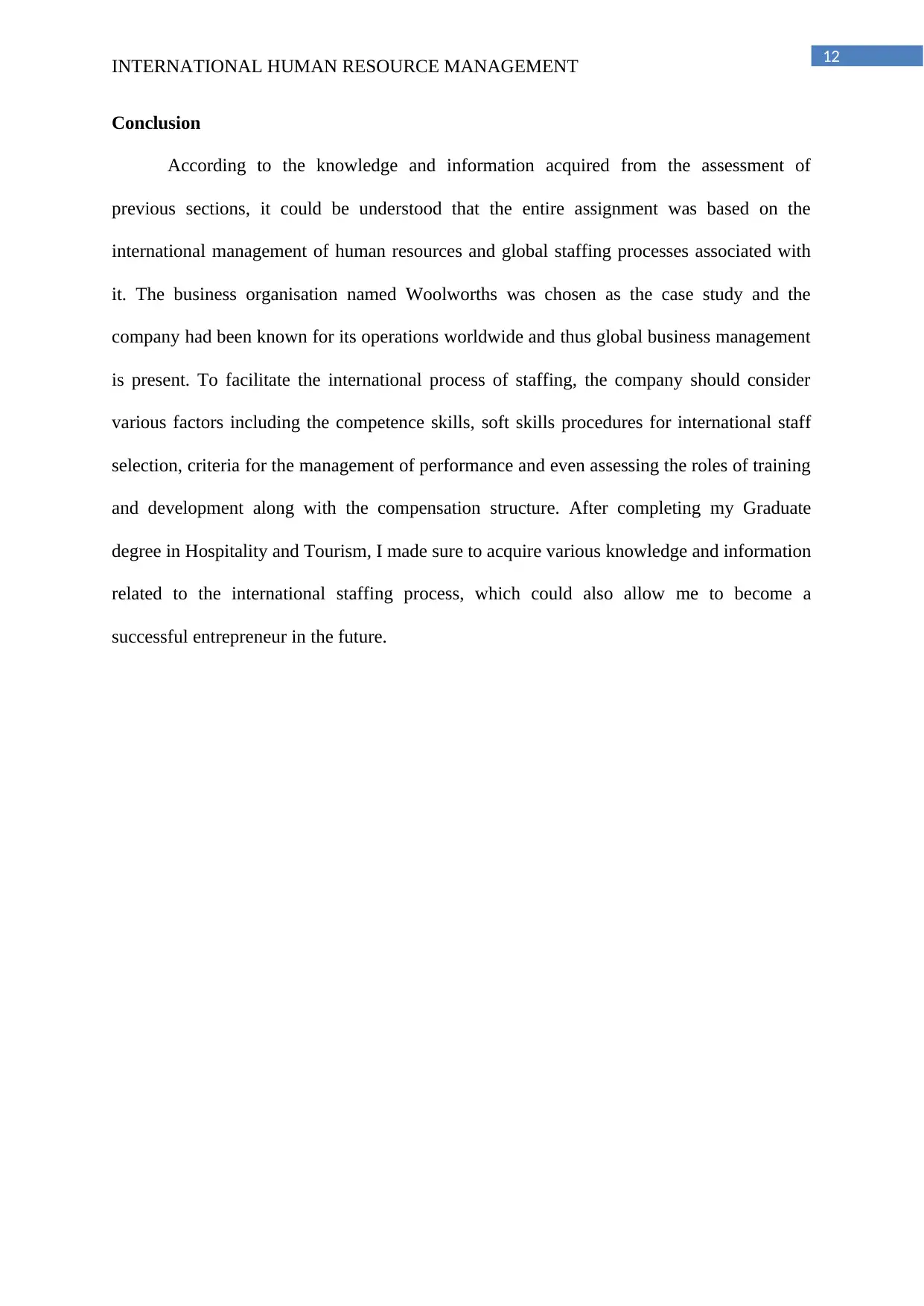
12
INTERNATIONAL HUMAN RESOURCE MANAGEMENT
Conclusion
According to the knowledge and information acquired from the assessment of
previous sections, it could be understood that the entire assignment was based on the
international management of human resources and global staffing processes associated with
it. The business organisation named Woolworths was chosen as the case study and the
company had been known for its operations worldwide and thus global business management
is present. To facilitate the international process of staffing, the company should consider
various factors including the competence skills, soft skills procedures for international staff
selection, criteria for the management of performance and even assessing the roles of training
and development along with the compensation structure. After completing my Graduate
degree in Hospitality and Tourism, I made sure to acquire various knowledge and information
related to the international staffing process, which could also allow me to become a
successful entrepreneur in the future.
INTERNATIONAL HUMAN RESOURCE MANAGEMENT
Conclusion
According to the knowledge and information acquired from the assessment of
previous sections, it could be understood that the entire assignment was based on the
international management of human resources and global staffing processes associated with
it. The business organisation named Woolworths was chosen as the case study and the
company had been known for its operations worldwide and thus global business management
is present. To facilitate the international process of staffing, the company should consider
various factors including the competence skills, soft skills procedures for international staff
selection, criteria for the management of performance and even assessing the roles of training
and development along with the compensation structure. After completing my Graduate
degree in Hospitality and Tourism, I made sure to acquire various knowledge and information
related to the international staffing process, which could also allow me to become a
successful entrepreneur in the future.
Paraphrase This Document
Need a fresh take? Get an instant paraphrase of this document with our AI Paraphraser
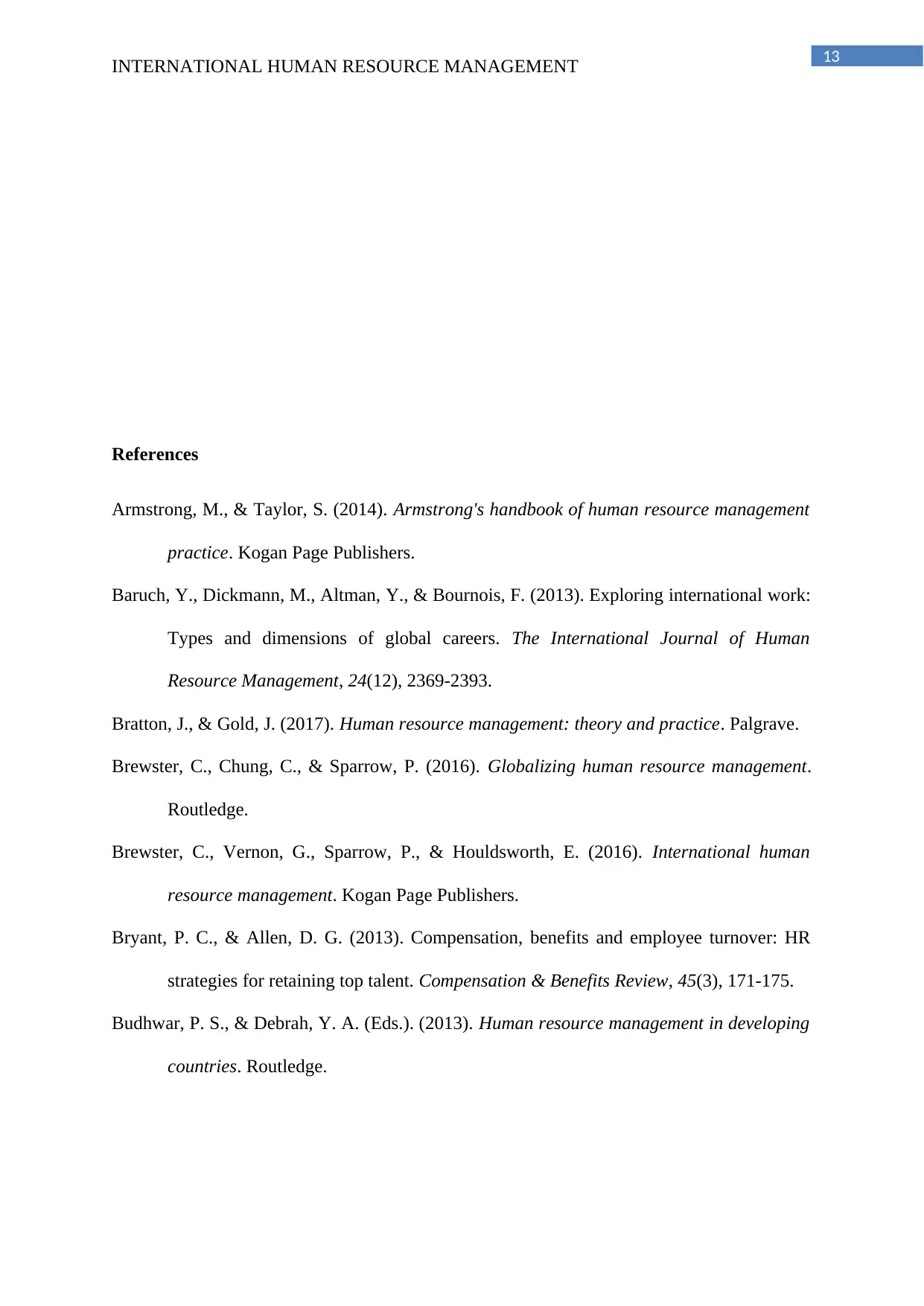
13
INTERNATIONAL HUMAN RESOURCE MANAGEMENT
References
Armstrong, M., & Taylor, S. (2014). Armstrong's handbook of human resource management
practice. Kogan Page Publishers.
Baruch, Y., Dickmann, M., Altman, Y., & Bournois, F. (2013). Exploring international work:
Types and dimensions of global careers. The International Journal of Human
Resource Management, 24(12), 2369-2393.
Bratton, J., & Gold, J. (2017). Human resource management: theory and practice. Palgrave.
Brewster, C., Chung, C., & Sparrow, P. (2016). Globalizing human resource management.
Routledge.
Brewster, C., Vernon, G., Sparrow, P., & Houldsworth, E. (2016). International human
resource management. Kogan Page Publishers.
Bryant, P. C., & Allen, D. G. (2013). Compensation, benefits and employee turnover: HR
strategies for retaining top talent. Compensation & Benefits Review, 45(3), 171-175.
Budhwar, P. S., & Debrah, Y. A. (Eds.). (2013). Human resource management in developing
countries. Routledge.
INTERNATIONAL HUMAN RESOURCE MANAGEMENT
References
Armstrong, M., & Taylor, S. (2014). Armstrong's handbook of human resource management
practice. Kogan Page Publishers.
Baruch, Y., Dickmann, M., Altman, Y., & Bournois, F. (2013). Exploring international work:
Types and dimensions of global careers. The International Journal of Human
Resource Management, 24(12), 2369-2393.
Bratton, J., & Gold, J. (2017). Human resource management: theory and practice. Palgrave.
Brewster, C., Chung, C., & Sparrow, P. (2016). Globalizing human resource management.
Routledge.
Brewster, C., Vernon, G., Sparrow, P., & Houldsworth, E. (2016). International human
resource management. Kogan Page Publishers.
Bryant, P. C., & Allen, D. G. (2013). Compensation, benefits and employee turnover: HR
strategies for retaining top talent. Compensation & Benefits Review, 45(3), 171-175.
Budhwar, P. S., & Debrah, Y. A. (Eds.). (2013). Human resource management in developing
countries. Routledge.
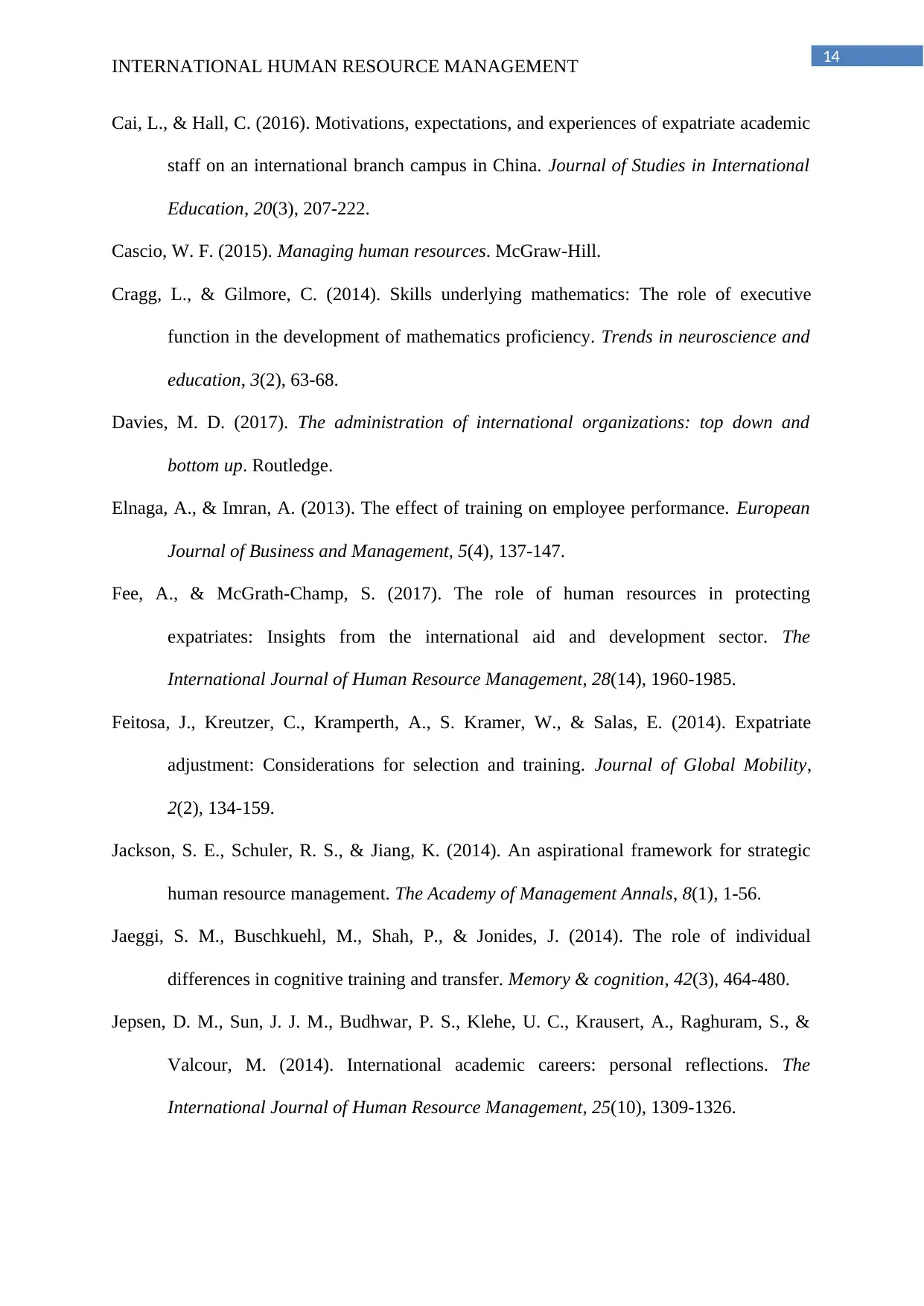
14
INTERNATIONAL HUMAN RESOURCE MANAGEMENT
Cai, L., & Hall, C. (2016). Motivations, expectations, and experiences of expatriate academic
staff on an international branch campus in China. Journal of Studies in International
Education, 20(3), 207-222.
Cascio, W. F. (2015). Managing human resources. McGraw-Hill.
Cragg, L., & Gilmore, C. (2014). Skills underlying mathematics: The role of executive
function in the development of mathematics proficiency. Trends in neuroscience and
education, 3(2), 63-68.
Davies, M. D. (2017). The administration of international organizations: top down and
bottom up. Routledge.
Elnaga, A., & Imran, A. (2013). The effect of training on employee performance. European
Journal of Business and Management, 5(4), 137-147.
Fee, A., & McGrath-Champ, S. (2017). The role of human resources in protecting
expatriates: Insights from the international aid and development sector. The
International Journal of Human Resource Management, 28(14), 1960-1985.
Feitosa, J., Kreutzer, C., Kramperth, A., S. Kramer, W., & Salas, E. (2014). Expatriate
adjustment: Considerations for selection and training. Journal of Global Mobility,
2(2), 134-159.
Jackson, S. E., Schuler, R. S., & Jiang, K. (2014). An aspirational framework for strategic
human resource management. The Academy of Management Annals, 8(1), 1-56.
Jaeggi, S. M., Buschkuehl, M., Shah, P., & Jonides, J. (2014). The role of individual
differences in cognitive training and transfer. Memory & cognition, 42(3), 464-480.
Jepsen, D. M., Sun, J. J. M., Budhwar, P. S., Klehe, U. C., Krausert, A., Raghuram, S., &
Valcour, M. (2014). International academic careers: personal reflections. The
International Journal of Human Resource Management, 25(10), 1309-1326.
INTERNATIONAL HUMAN RESOURCE MANAGEMENT
Cai, L., & Hall, C. (2016). Motivations, expectations, and experiences of expatriate academic
staff on an international branch campus in China. Journal of Studies in International
Education, 20(3), 207-222.
Cascio, W. F. (2015). Managing human resources. McGraw-Hill.
Cragg, L., & Gilmore, C. (2014). Skills underlying mathematics: The role of executive
function in the development of mathematics proficiency. Trends in neuroscience and
education, 3(2), 63-68.
Davies, M. D. (2017). The administration of international organizations: top down and
bottom up. Routledge.
Elnaga, A., & Imran, A. (2013). The effect of training on employee performance. European
Journal of Business and Management, 5(4), 137-147.
Fee, A., & McGrath-Champ, S. (2017). The role of human resources in protecting
expatriates: Insights from the international aid and development sector. The
International Journal of Human Resource Management, 28(14), 1960-1985.
Feitosa, J., Kreutzer, C., Kramperth, A., S. Kramer, W., & Salas, E. (2014). Expatriate
adjustment: Considerations for selection and training. Journal of Global Mobility,
2(2), 134-159.
Jackson, S. E., Schuler, R. S., & Jiang, K. (2014). An aspirational framework for strategic
human resource management. The Academy of Management Annals, 8(1), 1-56.
Jaeggi, S. M., Buschkuehl, M., Shah, P., & Jonides, J. (2014). The role of individual
differences in cognitive training and transfer. Memory & cognition, 42(3), 464-480.
Jepsen, D. M., Sun, J. J. M., Budhwar, P. S., Klehe, U. C., Krausert, A., Raghuram, S., &
Valcour, M. (2014). International academic careers: personal reflections. The
International Journal of Human Resource Management, 25(10), 1309-1326.
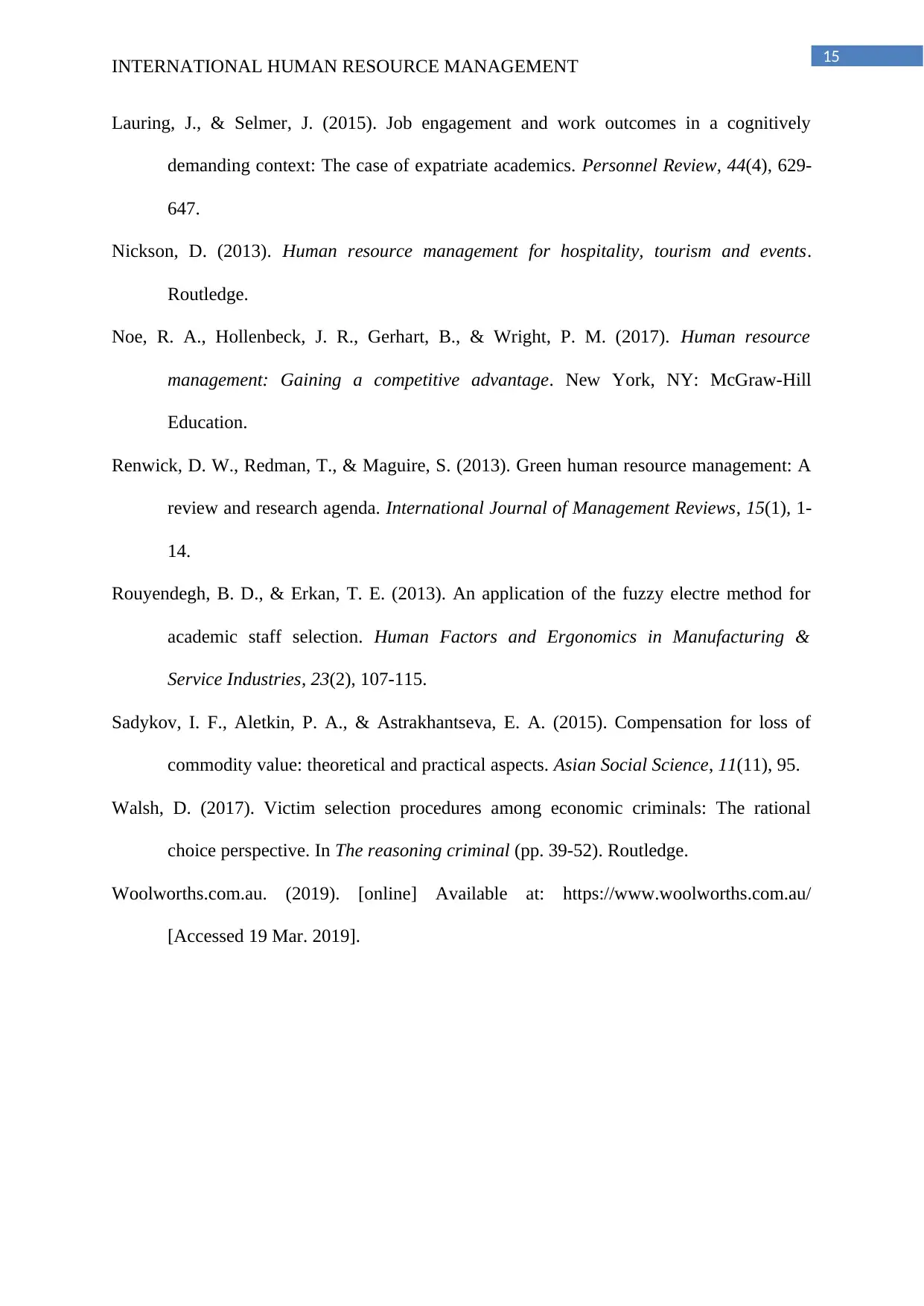
15
INTERNATIONAL HUMAN RESOURCE MANAGEMENT
Lauring, J., & Selmer, J. (2015). Job engagement and work outcomes in a cognitively
demanding context: The case of expatriate academics. Personnel Review, 44(4), 629-
647.
Nickson, D. (2013). Human resource management for hospitality, tourism and events.
Routledge.
Noe, R. A., Hollenbeck, J. R., Gerhart, B., & Wright, P. M. (2017). Human resource
management: Gaining a competitive advantage. New York, NY: McGraw-Hill
Education.
Renwick, D. W., Redman, T., & Maguire, S. (2013). Green human resource management: A
review and research agenda. International Journal of Management Reviews, 15(1), 1-
14.
Rouyendegh, B. D., & Erkan, T. E. (2013). An application of the fuzzy electre method for
academic staff selection. Human Factors and Ergonomics in Manufacturing &
Service Industries, 23(2), 107-115.
Sadykov, I. F., Aletkin, P. A., & Astrakhantseva, E. A. (2015). Compensation for loss of
commodity value: theoretical and practical aspects. Asian Social Science, 11(11), 95.
Walsh, D. (2017). Victim selection procedures among economic criminals: The rational
choice perspective. In The reasoning criminal (pp. 39-52). Routledge.
Woolworths.com.au. (2019). [online] Available at: https://www.woolworths.com.au/
[Accessed 19 Mar. 2019].
INTERNATIONAL HUMAN RESOURCE MANAGEMENT
Lauring, J., & Selmer, J. (2015). Job engagement and work outcomes in a cognitively
demanding context: The case of expatriate academics. Personnel Review, 44(4), 629-
647.
Nickson, D. (2013). Human resource management for hospitality, tourism and events.
Routledge.
Noe, R. A., Hollenbeck, J. R., Gerhart, B., & Wright, P. M. (2017). Human resource
management: Gaining a competitive advantage. New York, NY: McGraw-Hill
Education.
Renwick, D. W., Redman, T., & Maguire, S. (2013). Green human resource management: A
review and research agenda. International Journal of Management Reviews, 15(1), 1-
14.
Rouyendegh, B. D., & Erkan, T. E. (2013). An application of the fuzzy electre method for
academic staff selection. Human Factors and Ergonomics in Manufacturing &
Service Industries, 23(2), 107-115.
Sadykov, I. F., Aletkin, P. A., & Astrakhantseva, E. A. (2015). Compensation for loss of
commodity value: theoretical and practical aspects. Asian Social Science, 11(11), 95.
Walsh, D. (2017). Victim selection procedures among economic criminals: The rational
choice perspective. In The reasoning criminal (pp. 39-52). Routledge.
Woolworths.com.au. (2019). [online] Available at: https://www.woolworths.com.au/
[Accessed 19 Mar. 2019].
1 out of 16
Related Documents
Your All-in-One AI-Powered Toolkit for Academic Success.
+13062052269
info@desklib.com
Available 24*7 on WhatsApp / Email
![[object Object]](/_next/static/media/star-bottom.7253800d.svg)
Unlock your academic potential
© 2024 | Zucol Services PVT LTD | All rights reserved.




